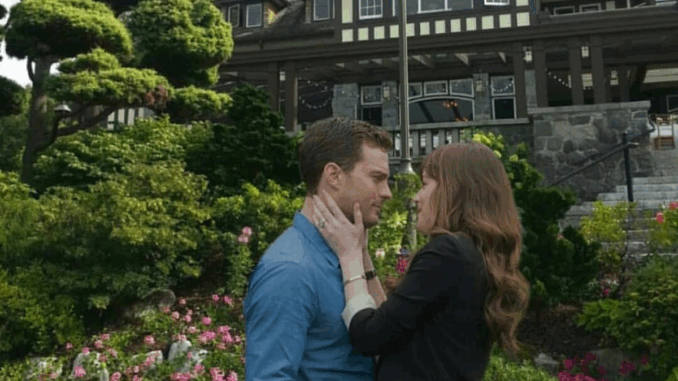
Trapped in a Franchise They Secretly Resented
When Fifty Shades of Grey hit theaters, it was marketed as an explosive, forbidden love story—bold, sensual, and emotional. But as fans watched Christian Grey and Anastasia Steele fall into their twisted, controlling relationship on-screen, something far more complicated was happening off-screen. Behind the glossy posters and millions in ticket sales, Jamie Dornan and Dakota Johnson were quietly unraveling—not from passion, but from exhaustion, frustration, and regret.
The truth? Neither of them truly wanted to be there.
Jamie Dornan, the mysterious, brooding face of Christian Grey, has always distanced himself from the character. “I am not him,” he once said curtly during a press tour. What fans didn’t see behind that calm exterior was a growing resentment—toward the role, the creative control he didn’t have, and the pressure to embody someone he privately found “cold and unrelatable.”
Dakota Johnson’s experience wasn’t any easier. “We were not allowed to improvise. We couldn’t change lines. We couldn’t breathe wrong,” she admitted years later. What was sold as a liberating romance turned out to be a tightly controlled, creatively suffocating production, where even the actors’ instincts were dismissed in favor of following the book to the letter.
And then, there were the scenes that never made it into the final cut.
Multiple insiders have confirmed that entire sequences were scrapped after backlash from internal test audiences and nervous studio executives. One particularly controversial deleted scene reportedly showed Christian exerting disturbing levels of psychological control over Ana—even Jamie himself refused to film it without rewriting it first. His objection was noted, but ultimately, the studio moved forward anyway—only to cut the scene in post-production after backlash from internal screenings.
Dakota, meanwhile, was asked to reshoot a scene four times until she gave the director an expression that looked “more afraid, less angry.” She eventually walked off set in silence.
Their on-screen chemistry? It was manufactured. In real life, while they were professional and civil, they weren’t close. In fact, insiders described their relationship as “tense but polite.” Jamie was uncomfortable with many of the explicit demands of the role and hated being typecast. Dakota was furious with the lack of artistic freedom.

“It was like being in a glass cage,” she later told Vanity Fair, referencing the intense fan expectations and suffocating press obligations. Even when the cameras stopped rolling, they were never truly free from these characters.
What’s worse, they couldn’t walk away.
Both Jamie and Dakota had signed contracts locking them into three films. Quitting wasn’t an option. And with each new sequel—Fifty Shades Darker, Fifty Shades Freed—the emotional weight grew heavier. The press tours became more rehearsed. The smiles more forced. The interviews more vague.
When asked in 2022 if he regretted the trilogy, Jamie paused for an uncomfortably long moment before answering: “I don’t regret it… but I wouldn’t do it again.”
Dakota didn’t hesitate: “If I had known what it was really going to be like, I might have said no.”
In the end, Fifty Shades did make them household names. But the cost was high. They were packaged as icons of forbidden desire—when in truth, they were playing characters they barely recognized, in stories they couldn’t control.
Now, years later, both actors have moved on—to other roles, other projects, other identities. But no matter what they do, for millions around the world, they will always be Christian and Ana.
And that, perhaps, is the cruelest twist of all.
